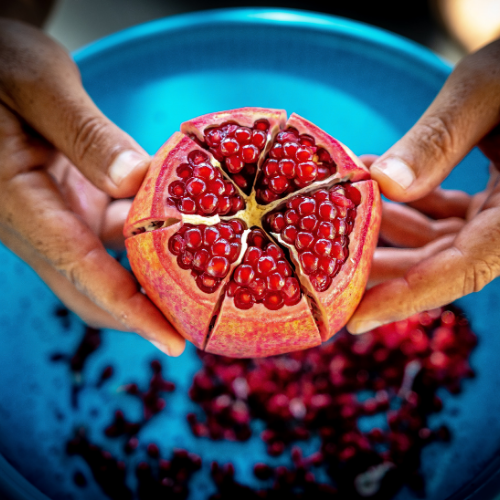Pomegranates find their way onto grocery store shelves at this time of year and many people overlook them because they don’t know what to do with them. The pomegranate is an ancient fruit with a rich history in myth, symbol art, medicine and religion. One of the earliest cultivated fruits, the pomegranate has been traced back as far as 3,000 B.C. Some scholars even suggest that it was a pomegranate, not an apple, that tempted Eve.
Pomegranates have quite a history and are presently (maybe once again), the latest craze for health food fanatics. The name for the pomegranate fruit is derived from Latin and literally means “seeded apple.” Only the seeds are edible and are found inside this large, hexagonal-shaped red fruit. Bitter, inedible membranes hold the seeds, and getting the seeds out can be a struggle — although it doesn’t have to be (see below).
An average pomegranate contains about 600 juicy seeds.
They are also known as arils, which are encapsulated in white pith. The pomegranate fruit is low in calories, high in fiber, high in vitamins and high in phytochemicals that may promote heart health and help to prevent cancer. Their vibrant red seeds make wonderful soups, they can be sprinkled into a green salad for color and crunch, or used in baked goods, sauces and ice cream. You also can just put a bunch of them in a bowl to use as a centerpiece. Scientists say the leathery-skinned, orange-sized fruit with the sweet-tart juice is loaded with antioxidants, vitamins, potassium, folic acid and iron. Pomegranates are the new superfood.
One of my favorite fruits, pomegranates offer more than just incredible taste—they are nutritional and healing powerhouses. They contain plentiful amounts of antioxidants, which are essential to optimizing health. New research in the journal Renal Failure showed than an extract of pomegranate prevented kidney damage and protected the kidneys against harmful toxins. They are also a good source of two essential vitamins, C and K. The immune boosting Vitamin C is a quickly depleted nutrient at this time of year, so stock up on pomegranates. It aids in immune system function, wound healing, promotion of healthy gums and the manufacture of collagen and elastin. Vitamin C also enhances iron absorption. Pomegranate seeds provide slightly more than 16 mcg of vitamin K, or 20 percent of the DV, according to NutritionValue.org. Vitamin K is important for maintaining strong, healthy bones, as well as, proper blood clotting.
One of the most important facts that researchers have found, shows that pomegranates help regulate blood sugar, improves the body’s sensitivity to insulin, decreases inflammation, and improves numerous other factors involved in metabolic syndrome—frequently implicated in obesity and often a precursor to diabetes. Because of these affects, they may aid in weight loss!
I’ve been using pomegranate seeds in my holiday recipes for years and have always enlisted my kids to open them as they could be pretty messy. I would shield them with an apron and hope for the best as they got sprayed with the red juice staining many outfits. So the easiest, cleanest and least time consuming way to get the seeds out of a pomegranate is to cut just through the skin around the entire pomegranate, not all the way to the center. You’ll feel the give when you get through the skin. Cutting all the way to the center just ruins a line of arils (seeds). Repeat in the opposite direction to make 4 equal sections. Gently pull the sections apart. One at a time, submerge the pomegranate sections in a deep bowl of water. (This is the secret weapon for keeping your clothes from getting stained!) Rub your thumb over the seeds to loosen them. The seeds will sink to the bottom and the white flesh will float, making it easy to skim. Then scoop off the white debris, drain the pomegranate seeds, and dry on a paper towel. Store in the refrigerator in an airtight container until ready to serve.
Pomegranate Mango Guacamole
Folding fruit into guacamole is an inspired tradition in Mexican cooking. Tropical mangoes are a natural pairing, their silky flesh adding a subtle tartness to creamy avocado. To herald the holiday season, pomegranate seeds flash bright red against the guacamole’s cilantro-flecked green.
Ingredients
4 ripe avocados (2 pounds total)
1 cup finely chopped white onion
2 fresh serrano chiles, finely chopped (2 tablespoons), including seeds
1/4 cup fresh lime juice, or to taste
3/4 cup pomegranate seeds (from 1 pomegranate)
3/4 cup diced peeled mango
1/2 cup chopped cilantro
1/4 tsp. sea salt
Preparation
1. Halve, pit, and peel avocados. Coarsely mash in a bowl.
2. Stir in onion, chiles, lime juice, and salt, then fold in pomegranate seeds, mango, and cilantro.
3. Season with additional salt if necessary and additional lime juice.
Note:Guacamole can be made 4 hours ahead and chilled, its surface covered with parchment paper or plastic wrap. Bring to room temperature and stir before serving.

